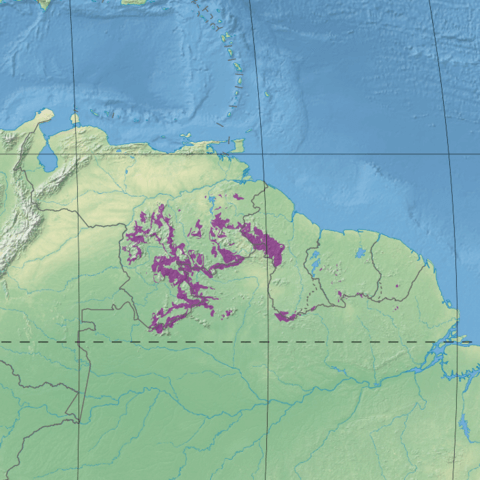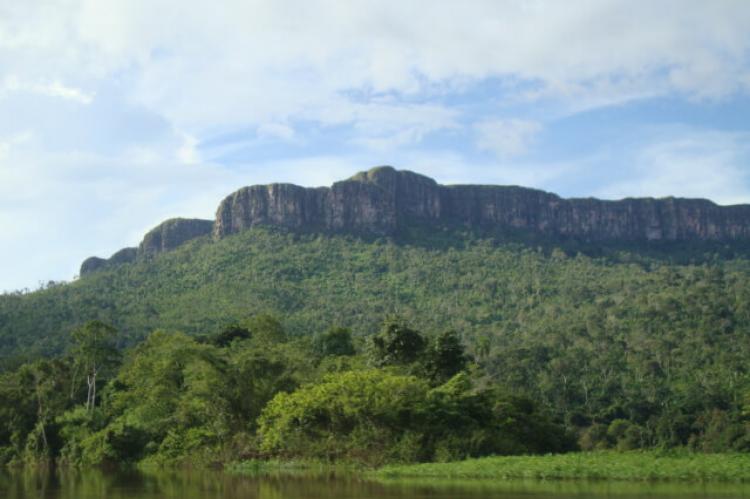Guianan Highlands Moist Forests Ecoregion (South America)
Situated primarily in southeastern Venezuela, the Guianan Highlands moist forests ecoregion is distinct from other ecoregions in Amazonia due to its montane physiography. It hosts vast expanses of tall primary rainforests and open, semi-treeless savannas interrupted by gallery forests.
Guianan Highlands Moist Forests
Due to its montane physiography, the Guianan Highlands moist forests ecoregion is distinct from other ecoregions in Amazonia. It hosts vast expanses of tall primary rainforest and open, semi-treeless savannas interrupted by gallery forests.
Portions of the Guianan Highlands moist forests ecoregion lie in southern Venezuela, western and southern Guyana and northern Brazil, with scattered portions in Suriname, French Guiana, and eastern Colombia.
Most of this ecoregion lies within the eastern portion of the Orinoco Basin, which drains into the Caribbean Sea from Venezuela. Another portion drains into the Amazon Basin.
The major rivers entering the Orinoco Basin from this ecoregion are the Orinoco headwaters, the Ventuari, Caroní, Paragua, and Caura in Venezuela. In the southern portions, the Rio Uraricuera and Rio Branco (in Brazil) drain into the Amazon.
The Guianan Highlands moist forests ecoregion sits upon the Guiana Shield, which underlies the northern region of South America. It consists of a rock basement with various igneous and metamorphic rocks formed during different geological events.
The upland terraces and mountains of the Guiana Shield are remnants of highly weathered and ancient parent material consisting primarily of quartzitic or sandstone rocks. However, granitic rock types persist in some areas.
The lowland plains emerged only recently from lacustrine and marine environments. As a result, the soils are generally sandy and poor in nutrients.
The seasonal climate is humid to sub-humid, with 2,000 - 2,400 mm (78 - 95 in) of rainfall distributed evenly throughout the year. The average annual temperature is approximately 24 °C (75 °F).
Flora and Fauna
The Guianan Highlands moist forests host more than 200 mammals. Many are widespread Amazonian species, including jaguars (Panthera onca), pumas (Puma concolor), tapirs (Tapirus terrestris), two peccaries (Tayassu pecari and T. tajacu), and deer (Mazama spp.). Other mammals with a restricted distribution include opossums, bats, and rodents.
Endemic species include the olingo (Bassaricyon beddardi) and the rodents (Sciurus flammifer, Proechimys hoplomyoides and Dasyprocta guamara).
The avifauna comprises more than 600 species, a few of which are endemic. Several species have a restricted distribution, however, including white-cheeked pintails (Anas bahamensis), aplomado falcons (Falco femoralis), brown-throated parakeets (Aratinga pertinax), pavonine cookoos (Dromococcyx pavoninus), vermiculated screech owls (Otus guatemalae), burrowing owls (Athene cunicularia), five species of emeralds and hummingbirds in the Amazilia genera, chestnut-tipped toucans (Aulacorhynchus derbianus), smoke-colored peewees (Contopus fumigatus), orange-crowned orioles (Icterus auricapillus), gray seedeaters (Sporophila intermedia), two-banded warblers (Basileuterus bivittatus), and black-backed water-tyrants (Fluvicola albiventer).
Reptiles and amphibians are abundant. The more famous snakes that occur here include the fer-de-lance (Bothrops asper), palm pit-vipers (Bothriechis spp.), coral snakes (Micrurus spp.), boa constrictors (Boa constrictor), bushmasters (Lachesis muta). Iguanas (Iguana iguana) are ubiquitous and tegus lizards (Tupinambis) common.
Protection Status
Habitat destruction from large-scale agriculture, mining, and cattle raising occurs mainly along the northern and northeastern periphery of the ecoregion, nearest to urban centers.
Many of the interior forests of the Guayana Highlands Moist Forests ecoregion are intact. However, recently, impacts have begun to be felt further into the heart of the ecoregion.
Notable protected areas that are part of or within the ecoregion include:
-
Parima-Tapirapecó National Park
-
Serranía La Neblina National Park
-
Pico da Neblina National Park

Map depicting the location of the Guianan Highlands moist forests ecoregion (in purple)
